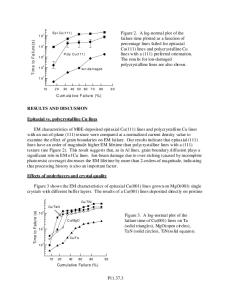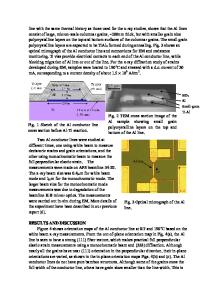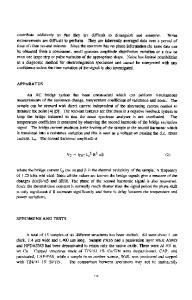Quantitative Analysis of Electromigration Damage in Al-based Conductor Lines
- PDF / 329,578 Bytes
- 11 Pages / 612 x 792 pts (letter) Page_size
- 56 Downloads / 298 Views
MATERIALS RESEARCH
Welcome
Comments
Help
Quantitative analysis of electromigration damage in Al-based conductor lines O. Kraft, J. E. Sanchez, Jr.,a) M. Bauer,b) and E. Arzt Max-Planck-Institut f¨ur Metallforschung and Institut f¨ur Metallkunde der Universit¨at, 70174 Stuttgart, Germany (Received 20 November 1995; accepted 30 April 1997)
Electromigration damage in Al-based interconnects with three compositions (pure Al, Al–1%Si –0.5%Cu, and Al –2%Cu) was studied quantitatively. Using scanning electron microscopy, the spacings between more than 1000 voids and hillocks were measured. The distribution of the spacings was found to be a function of the composition, the applied current density, and the linewidth. The measurements confirm the existence of a threshold product of current density and diffusion length. In particular, a dependence of this threshold product on the Cu content was found. The results of the analysis show that there are clear correlations between the details of the microscopic damage processes and the lifetime of the conductor lines. I. INTRODUCTION
The progress in computer technology in the last three decades is closely related to the miniaturization of all components in the integrated circuits. As a result, the reliability of the miniaturized devices has become an important issue for the microelectronics industry. Especially, failure of the metallic interconnects by voiding due to electromigration and mechanical stresses has been identified as a potential technological problem. The phenomenon of electromigration, a mechanism for the transport of matter, has been the subject of many investigations (for a recent review see Ref. 1). It is common to characterize the electromigration behavior of interconnects by measuring time-to-failure distributions under accelerated testing conditions (e.g., Refs. 2 and 3). In addition, it is the aim of many publications to develop physical models that predict the lifetime of the conductor lines as a function of linewidth, microstructure, and testing conditions (e.g., Refs. 4–7). In many of these investigations the interaction between electromigration and mechanical stresses plays an important role. This relationship was investigated by Blech and co-workers for the first time.8–10 They observed that a critical current density is needed in order to produce an electromigration-induced drift of an aluminum stripe on a TiN layer. This effect was attributed to the occurrence of a stress-induced mass flux opposite to the electromigration flux. In Blech’s model the resulting drift velocity y of the stripe is given by: µ ∂ D Ds p y2 eZ rj 2 V , (1) kT l a)
Now at Materials Science and Engineering, The University of Michigan, Ann Arbor, Michigan 48109-2136. b) Now at Siemens AG, 93009 Regensburg, Germany. J. Mater. Res., Vol. 12, No. 8, Aug 1997
http://journals.cambridge.org
Downloaded: 14 Mar 2015
where j is the current density, l the length of the stripe, eZ p the effective charge, r the resistivity, and V the atomic volume. D is the effective diffusion coeffic
Data Loading...











